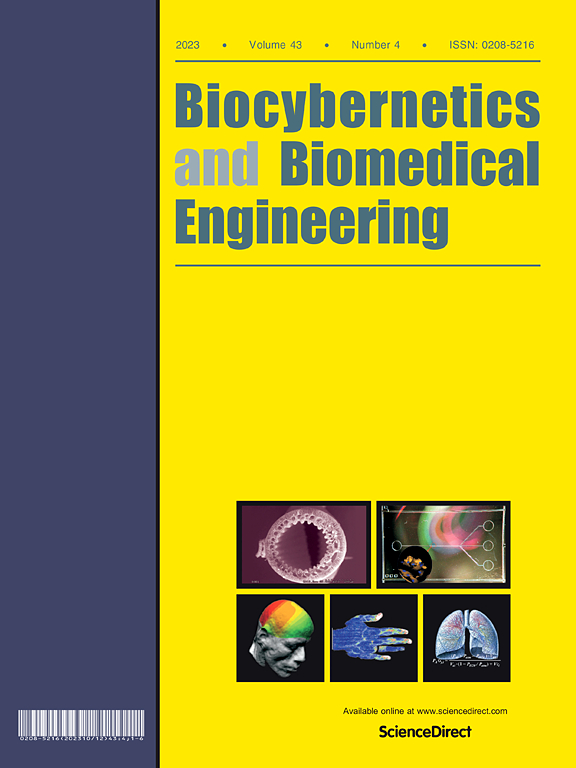TRI-based heart rate variability parameterisation: advancing autonomic dysfunction assessment in diabetes and aging—A cross-sectional observational study
IF 6.6
2区 医学
Q1 ENGINEERING, BIOMEDICAL
引用次数: 0
Abstract
This cross-sectional observational study introduces the T-R interval (TRI), a novel electrocardiographic parameter designed to improve heart rate variability (HRV) assessment in ageing and diabetic populations. Defined as the R-R interval (RRI) minus the heart rate-corrected RT interval (RTc), TRI incorporates both depolarisation and repolarisation phases of the cardiac cycle, thereby offering deeper insights into autonomic function. A total of 126 participants, including 58 individuals with type 2 diabetes mellitus and 68 healthy controls, were assessed using conventional HRV indices. These included the low-to-high frequency power ratio (LHR), the short-to-long variability ratio (SSR), and the baroreflex entropy index (BEI), all of which were calculated from both RRI and TRI data. TRI-based indices demonstrated superior sensitivity in detecting autonomic dysfunction. Significant group differences were observed for TRI-derived MSELS (mean difference = 0.205, 95 % CI: 0.093–0.317, p = 0.036), SSR (mean difference = − 0.083, 95 % CI: −0.136–−0.029, p = 0.051), and BEI (mean difference = 0.205, 95 % CI: 0.093–0.318, p = 0.002), while their RRI-based equivalents did not reach statistical significance. ROC curve analysis showed improvements in the area under the curve (AUC) when TRI was used as the input parameter, with gains of 5.9 % for MSELS, 10.6 %for SSR, and 6.1 % for BEI. Logistic regression further identified TRI-based BEI as a protective factor against new-onset T2DM (OR = 0.058; 95 % CI: 0.009–0.378; p = 0.003). These findings suggest that TRI improves the diagnostic performance of HRV analysis and may support earlier detection of autonomic dysfunction, especially in clinical and wearable monitoring settings.
基于三自由度的心率变异性参数化:推进糖尿病和衰老的自主神经功能障碍评估——一项横断面观察研究
这项横断面观察性研究引入了T-R间隔(TRI),这是一种新的心电图参数,旨在改善老年人和糖尿病人群的心率变异性(HRV)评估。TRI被定义为R-R间期(RRI)减去心率校正后的RT间期(RTc),它结合了心脏周期的去极化和复极化阶段,从而对自主神经功能提供了更深入的了解。共有126名参与者,包括58名2型糖尿病患者和68名健康对照者,使用常规HRV指数进行评估。其中低高频功率比(LHR)、短长变异性比(SSR)和气压反射熵指数(BEI)均由RRI和TRI数据计算得到。基于tri的指数在检测自主神经功能障碍方面表现出更高的灵敏度。tri衍生的MSELS(平均差异= 0.205,95% CI: 0.093-0.317, p = 0.036)、SSR(平均差异= - 0.083,95% CI: - 0.136 - - 0.029, p = 0.051)和BEI(平均差异= 0.205,95% CI: 0.093-0.318, p = 0.002)组间差异显著,而基于rri的等效性差异无统计学意义。ROC曲线分析显示,以TRI作为输入参数时,MSELS、SSR和BEI的曲线下面积(AUC)分别增加了5.9%、10.6%和6.1%。Logistic回归进一步确定基于三因素的BEI是预防新发T2DM的保护因素(OR = 0.058; 95% CI: 0.009-0.378; p = 0.003)。这些发现表明,TRI提高了HRV分析的诊断性能,并可能支持自主神经功能障碍的早期检测,特别是在临床和可穿戴监测设置中。
本文章由计算机程序翻译,如有差异,请以英文原文为准。
求助全文
约1分钟内获得全文
求助全文
来源期刊

Biocybernetics and Biomedical Engineering
ENGINEERING, BIOMEDICAL-
CiteScore
16.50
自引率
6.20%
发文量
77
审稿时长
38 days
期刊介绍:
Biocybernetics and Biomedical Engineering is a quarterly journal, founded in 1981, devoted to publishing the results of original, innovative and creative research investigations in the field of Biocybernetics and biomedical engineering, which bridges mathematical, physical, chemical and engineering methods and technology to analyse physiological processes in living organisms as well as to develop methods, devices and systems used in biology and medicine, mainly in medical diagnosis, monitoring systems and therapy. The Journal''s mission is to advance scientific discovery into new or improved standards of care, and promotion a wide-ranging exchange between science and its application to humans.
 求助内容:
求助内容: 应助结果提醒方式:
应助结果提醒方式:


